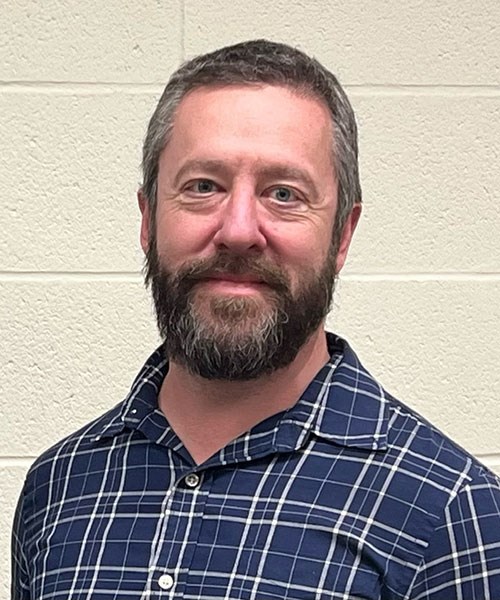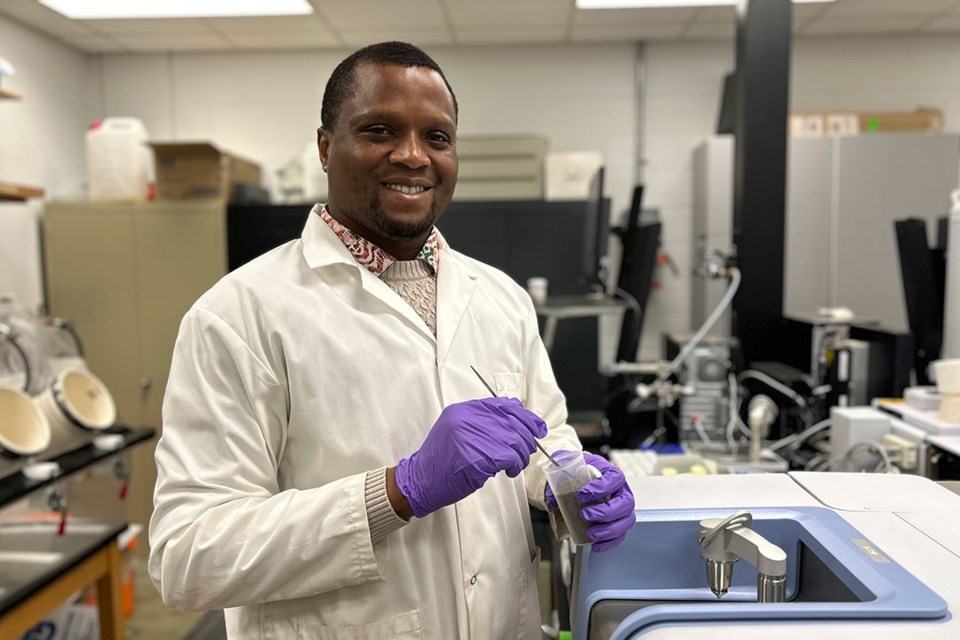SASKATOON — As the University of Saskatchewan (USask) joins the United Nations in observing World Soil Day on Dec. 5, College of Agriculture and Bioresources researchers are investigating the use of spectroscopy for soil testing.
Do you remember the device used by Dr. “Bones” McCoy on Star Trek? He’d point his tricorder at a patient and diagnose the medical problem within seconds.
That future may not be here yet, but if Dr. Derek Peak (PhD) and Gbenga Adejumo have their way, something similar will be coming soon for diagnosing soil fertility.
Peak, a professor of soil science in the College of Agriculture and Bioresources at the University of Saskatchewan (USask), and Adejumo, a PhD candidate, are exploring the use of spectroscopy in testing soil for properties such as organic carbon, nitrogen, moisture, and texture.
Spectroscopy peers closely at the chemical forms of things in natural systems.
Dr. Derek Peak (PhD), soil scientist in the Department of Soil Science, in USask’s College of Agriculture and Bioresources. Photo courtesy USask
“The real power of spectroscopy is that you can just directly shine a light on a (soil) sample and understand what’s going on in it,” Peak said. “Our current research is, how do we leverage what we know about spectroscopy to try to make better, cheaper, faster field-type measurements of soil fertility.”
Four years into the project, the two researchers are presently using the intense form of light at the Canadian Light Source (CLS) to view soil samples collected from agricultural lands across Saskatchewan.
“Synchrotrons are really powerful at giving you an advance idea of what’s happening in the system, but they’re not 100 per cent compatible with landscape scale, or regional scale, or global scale problems you might face as a soil scientist.”
And so, they are seeking a portable, on-the-ground solution. The idea is that their knowledge could be translated into a small, hand-held, farm-friendly device that might also alleviate the burden of sending away soil samples, which can be cumbersome, expensive and time-consuming.
“What everybody wants is, you just take the little gun, press it, it will tell you everything about the soil and what to do,” Peak said.
It could also work for big ag equipment manufacturers, who could put sensors on seeders, for example, “and whatever spot you’re at on the field, you take the spectrum and make cropping decision in the field based on that.”
As with the development of most technology, Peak and Adejumo are finding challenges along the way.
For example, “what might work in some parts of the world or some climates or some kinds of soil or cropping systems just doesn’t work as well here,” Peak noted. “Some of those challenges and how to alleviate some of the problems to scale that up is what Gbenga’s doctoral thesis is all about.”
Starting from scratch
The roots of the project grew from two others performed in the Benin Republic and Nigeria in 2011-12 and 2018. There, soil fertility maps were generated for vegetable production at specific sites in conjunction with the International Development Research Centre, a federal Crown.
“It was my first real exposure to how soil chemistry and having better nutrient data could improve the livelihoods of people,” Peak said. “There are no soil testing labs.
“If it turns out that analysis of a soil sample is going to cost $100, and you have to ship it to Canada, that’s just not going to happen (in Africa).”
While the present project is focused on Saskatchewan soils, Adejumo pointed to its global importance.
“This is a great opportunity to showcase how spectral sensing can revolutionize food security through effective soil fertility testing, particularly in developing nations.”
In Africa, they took systematic approaches to improving water use and nutrient management and used synchrotron light to see how these measures were working in samples provided by research partners.
They were then able to scale up the research to show what soil fertility was like in the ecozone they were working in.
“That was really useful, because it gave extension agents, professors and also farmers ... better knowledge on how to grow those vegetables,” Peak said.
“That’s what agronomists and certified crop professionals do in Canada. They take what’s already been done in terms of research and knowledge, they take your soil test and make informed suggestions on how to best manage your crops.”
Back in Canada
Peak and Adejumo started the local project with a partner and some seed money to see what infrared light was good at, “and from that we learned that it’s very good at looking at soil organic carbon and soil nitrogen.”
He then applied for a grant through the Saskatchewan Ministry of Agriculture’s Agriculture Development Fund to evaluate spectroscopy as a proxy for soil testing here.
Peak said he was fortunate to have guidance from research associate David Balmer and modeller Dr. Preston Sorensen (PhD).
“Gbenga has done the vast majority of the research here on how to build these models, how to take imperfect data and scale it out to the field,” Peak said.
Adejumo said one of the goals is ensuring good agricultural intensification and diversification, and for that “you really need a good soil fertility test.”
“It has to be cheap, low cost; it has to be rapid; it has to be environmentally friendly; and it should not be destructive,” he said.
Unfortunately, he said soil testing costs can be considerable and destructive due to the use of chemicals.
Spectroscopy simply shines a light on the soil.
From that, Peak said “we extract useful information, and then we can use biometrics, modal techniques and statistics to correlate the useful information to the soil properties, especially soil organic carbon and nitrogen levels, which are major factors in soil fertility analysis.”
Work in progress
Adejumo has taken samples from soil zones and agricultural systems all over the province and built a model that can predict with “reasonable accuracy” the content of soil organic carbon and total nitrogen.
However, the team found that soil in some parts of the province contains a lot of carbonate minerals, but the lab analysis wasn’t coming out quite right.
There was a challenge with the way carbon was С����Ƶ measured in the lab, which translated into poor performance of the model in the field.
“We went back and said we have to test these things in the lab in a different way. And that becomes very valuable broadly,” Peak said. “We now have methodology in the lab to deal with that so you can construct better models.”
Ultimately, the new tool would save shipping, chemicals, and energy for drying and grinding samples, not to mention an enormous amount of time.
Farmers and growers, instead of sending samples to labs for soil testing, will be able to use a probe get an answer “just like that,” Peak said.
“At the end of his project, I think we will have a path for how one would take lab-based spectroscopy and directly use it in the field.”
Peak said their work will lead to a spectral sensing tool that can revolutionize food security through effective soil fertility testing, particularly in developing nations.
— Submitted by USask Media Relations




